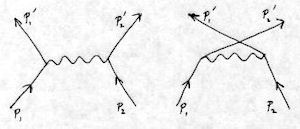Measuring the Skew of Document Images¶
| date: | Aug 31, 2006 |
|---|
As with most applications of practical importance, there have been many published papers, using diverse methods, on ways to determine the skew of document images. It may not come as a surprise that, notwithstanding the size of this bibliography, there is only one method that can be recommended for both speed and accuracy. It maximizes, in essence, the variance of differential line sums, where the line sums are the pixel projections taken at different angles. When the angle chosen is equal to the skew angle, the difference in pixel projections on adjacent raster lines, when squared and summed over all raster lines, has a maximum value. This method was first published by W. Postl in a 1988 U.S. patent, #4,723,297.
I can’t resist telling a little story here. Way back in 1991 I gave a paper at the first ICDAR Conference, held in the beautiful medieval town of St. Malo, France. The format had the speakers sitting at a table at the front of the room, and I was placed next to a well-known graybeard who had published a textbook on algorithms for image processing way back in 1982. We started talking about our recent work, and he said his paper was on segmenting a scanned document page that was skewed by a few degrees. I volunteered that it would be much harder to do that on a skewed page, and he agreed. So I asked him the obvious question: “Why do something so difficult when there is a much easier way to do it? Deskew the image first.” (I didn’t add a second reason: that the result of segmenting a scanned image is also expected to be much poorer if the image hasn’t been deskewed.) He replied that it would be preferable to deskew the image, but it was much too slow. I replied that surely it took longer to segment an image than to deskew it. No, he said, it takes at least a minute just to determine the skew angle. I was surprised, and asked him what method he was using for deskew. He said he was using a Hough Transform, but was vague on the details of the search scheme. I then told him that the skew angle could be found to sufficient accuracy in a few seconds using Postl’s variance of line sums (or of differential line sums). He was skeptical; if what I said was true, his attempt to solve a difficult problem was meaningless. There are several conclusions we can draw from this tale:
Don’t believe something just because an eminence grise says it is true — figure it out for yourself.
Always look for elegant solutions. They have lasting value and usually teach you something important, which can be used in other situations as well.
Remember two things about computer algorithms. Computers get faster in accordance with Moore’s Law, so you can assume that algorithms that are too slow today will eventually become practical. But, that being said, at any time, it is important to search for efficient methods.
How fast is deskew on a 1 GHz P3 with an 8 Mpixel image (standard page at 300 ppi) that is skewed about 1 degree? It depends on how much accuracy you want. But if you do it at 4x reduction, which will give you an accuracy of about 1/20 of a degree, it takes about 0.10 seconds to find the skew angle and about 0.12 seconds to rotate the image. That is less than 1/4 second in total. And on a 2.5 GHz P4, the entire operation will take less than 0.1 second. Just the blink of an eye.
For further reading . . .¶
I have written technical notes that summarize my understanding of the different methods and their relative merits and deficiencies, with emphasis (of course) on the method that uses the variance of differential line sums.
In the section on recent publications, you can find a paper where the preferred method for measuring skew is tested on a database of about 1000 pages.

